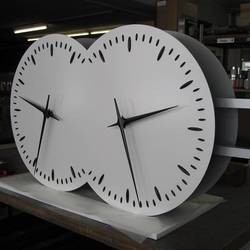Tik-Tok Tik-Tok
 Two clocks
A
and
B
of radii
r
and
R
respectively, with
r
<
R
, show the same time.
Two clocks
A
and
B
of radii
r
and
R
respectively, with
r
<
R
, show the same time.
The tip of the minute hand of which clock will move with greater speed ?
This section requires Javascript.
You are seeing this because something didn't load right. We suggest you, (a) try
refreshing the page, (b) enabling javascript if it is disabled on your browser and,
finally, (c)
loading the
non-javascript version of this page
. We're sorry about the hassle.
5 solutions
But when we measure the velocity for circular motion, we usually consider the angular velocity. And shouldn't the angular velocity be the same for both the clocks?
Log in to reply
I too thought the same way..:(
Angular velocity is same but not the linear speed. Linear speed is more for clock B (bigger than A) as linear velocity = angular velocity x radius.
Its SPEED which is asked, not VELOCITY.
Log in to reply
In my opinion, speed is an ambiguous term here which can either mean angular speed or linear speed and thus the problem needs to be rephrased.
Log in to reply
@Prasun Biswas – Agreed. Circular motion can be measured as angular speed or linear speed. This question must be rephrased.
@Prasun Biswas – In my opinion too.
@Prasun Biswas – i've edited the question
I too have the same question and the thinking in my mind,as inthe abovecomment
i've edited the question
Log in to reply
Great, but that doesn't help me much since my previous answer is still marked incorrect.
Just the TIP of the minute hand goes faster in B. Both minute hands (that is both a line all the way from center) goes 360 degrees in 60 minutes. If you had put them on top of each other you would see they move the same, but the tip of B's minute hand is further out and will have to travel further than the rest of both hands. I wondered if this was a trick question and wondered a long time to choose answer 2 or 4... Just rephrase it. ;)
Basically, v = ω r , right?
Easy,u can do it with 10 seconds. First,the clocks around the world have same angular speed,Then Omega(Angular speed)xR(Radii)=V(speed)
Greater the Radii,greater the speed :)
Speed of the tip of the minute hand in clock A within 60 minutes = 2(pi)r/60
Speed of the tip of the minute hand in clock B within 60 minutes = 2(pi)R/60
Since R> r, then
Speed of the tip of the minute hand in clock B is greater
The distance traveled in clock A = 2 × 22/7 × r = d
The distance traveled in clock B = 2 × 22/7 × R = D which is more than distance in clock A
Both the distances are traveled in same time of 60 min
so speeds are d/60 < D/60 so B travels fast.
v=2 x pi x R/T, so if R bigger, v must be bigger
The radius of the clock B is bigger, so it has to travel longer distance. the radius of the clock A is smaller. therefore the minute hand of clock B should travel with greater speed to match the correct time.